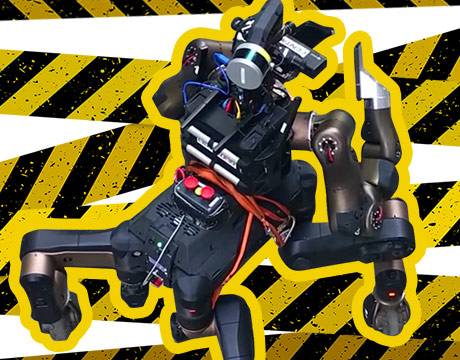These Rescue Robots Can Tackle Almost Any Disaster, Part 2
These Rescue Robots Can Tackle Almost Any Disaster, Part 2


The Centauro, one of the new robots used in rescue operations. Image: Italian Institute of Technology
In Part 1 of The 7 Coolest Rescue Robots Tackle Almost Any Disaster, we introduced you to the unnamed, Centauro, and Cheetah robots. Here are four more of the world’s coolest rescue robots.
4. Advanced Cockroach
Unlike the typical big and robust machines, these roach-inspired crawlers are lightweight and tiny. They are made to worm in and crawl through collapsed tunnels, fallen buildings, and other small and narrow terrains that humans can’t access. Some of them can also climb stairs and vertical passageways. While they are still in test mode, their inventor, David Zarrouk at Ben Gurion University in Israel, said these tiny inexpensive bots can look for survivors after earthquakes, inspect contaminated passageways, or help with other search and rescue tasks.
5. Data-collecting Platypus
Called Platypus, this miniature boat-like aquatic robot can navigate waterways polluted by oil spills or dumping while gathering water-quality data. It can carry multiple sensors and measure pH, dissolved oxygen, temperature, depth, and other vitals. And it can work incognito. Once, Platypus was disguised as a crocodile as it ventured out among the hippo pods wallowing in Kenya’s Mara River. It measured the amount of water pollution caused by hippos’ excrement. The decoy worked. The hippos tried attacking Platypus only once, said its creator, Paul Scerri.
6. TRADR on Tracks
TRADR was built to navigate dangerous and unpredictable environments, such as chemical spills, earthquake aftermaths or nuclear disasters. TRADR may be slow, but it’s very careful and meticulous. As it wheels through the unknown terrain, the robot uses a pair of flippers to probe the uncertain surfaces ahead and climb up and down piles of debris. Its name stands for Long-Term Human-Robot Teaming for Robot Assisted Disaster Response—and TRADR does exactly that. A team of these robots communicates with a human team and with each other as they map the dangerous area, note cleanup progress, or spot hazardous objects, such as a smoking pile or a barrel of gasoline. After researchers built the disaster recovery teams’ specs into TRADR, it performed well in earthquake situations, said project lead Ivana Kruijff-Korbayová from the German Research Center for Artificial Intelligence.
7. Autonomous Zipline
Zipline may not be a search airplane, but it certainly scores high on the rescue part. This autonomous fixed-wing style aircraft can deliver medicine or blood supply to the most remote corners of the world four times faster than the average quadcopter drone. It can fly at 128 km/h while carrying 1.75 kg of cargo, with a round trip range of 160 km. Contracted by the government of Rwanda to deliver blood, plasma and platelets to 21 hospitals across the western half of the country, Zipline drones conducted over 4,000 flights in the past two years—and about a third of them for emergency, life-saving situations. The company’s long term-mission is to expand such delivery services to the rest of the world.
Lina Zeldovich is an independent writer.
Read More Exclusive Stories from ASME.org:
How Elephants Use Their Tails to Chase Away Mosquitoes
Markforged’s Greg Mark on 3D Metal Printing, Additive Manufacturing
Global Talent Makes American Industry Stronger





